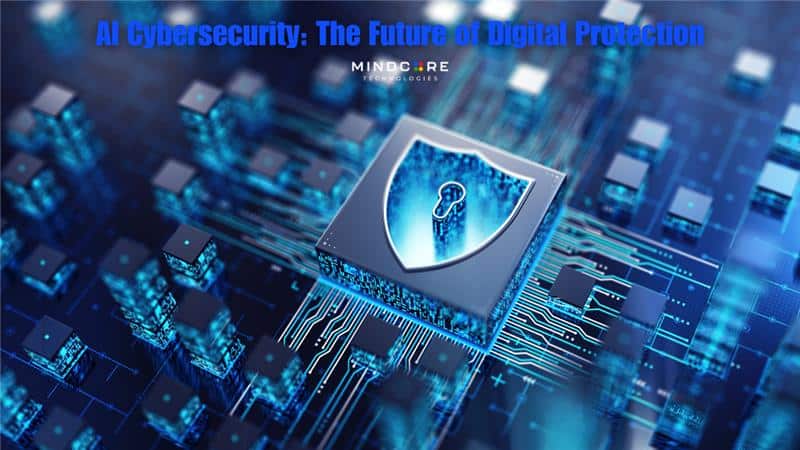In today’s world, cyberattacks are more common and more dangerous than ever before. From phishing scams to ransomware that locks down entire companies, digital threats continue to grow in both number and complexity. But there’s a powerful ally stepping into the spotlight: artificial intelligence. AI cybersecurity isn’t just a trend—it’s a new foundation for protecting data, businesses, and people in a digital-first world.
What Is AI Cybersecurity and Why Does It Matter?
AI cybersecurity helps to protect systems, networks, and data from digital threats using Artificial Intelligence. Whereas conventional tools tend to rely heavily on set rules and set manual inputs, AI systems can analyze patterns, learn from experience, and weigh options. Decisions are made on the spot which means faster response times to new threats and less chance for attackers to meet their objectives unnoticed.
This matters because cyber threats can develop faster than human teams working alone. AI does not get tired, takes no breaks, and basically analyzes an enormous amount of data in a matter of seconds. In the words of a store owner or companies, and IT teams, this means fewer risks and more confidence in staying protected
How AI Is Revolutionizing Cyber Threat Detection
Many traditional threat detection methods are, however, usually signature-based: they look for known patterns, such as a particular virus code. But what about the newer attacks? AI does the job by recognizing suspicious behaviors, even though this threat may never have been seen before.
The AI can monitor tiny aberrations in network behavior, such as heightened file transfer activities or tens of thousands of login attempts in a short span of time. Such suspicious behaviors may not seem dangerous to the human that is monitoring, but to an AI-powered system, it signals that something is amiss. With AI working in the background, powered by machine learning models, these threats can be detected more rapidly with fewer false positives than a human analyst.
This is even more important in industries that share sensitive information on a daily basis, such as e-commerce platforms and online services. An early detection facilitated by AI can safeguard businesses from financial damages due to downtime or data loss.
AI Cybersecurity Tools: Smart Defenses in Action
There are now many types of AI cybersecurity tools built for different parts of a security system. Some of the most common tools include:
- Predictive analytics tools: These tools look at past patterns to guess what might happen next. If a threat is likely to appear based on certain behaviors, these tools raise early warnings.
- Behavioral analysis platforms: These systems track user behavior to flag anything unusual. For example, if an employee logs in at 2 a.m. from another country, the system may act.
- AI-powered endpoint protection: These tools protect devices like laptops and phones, making sure malware or spyware can’t infect them.
These AI-based solutions aren’t just for large corporations. Many organizations are now adopting these intelligent defenses because they scale and adapt easily, providing flexible protection without the need for a full team of cybersecurity experts.
Key AI Technologies Transforming Cybersecurity
At the heart of AI cybersecurity are three core technologies:
- Machine Learning (ML): This allows systems to learn from experience. Over time, the system becomes smarter by recognizing patterns and improving its decision-making.
- Deep Learning (DL): A subset of ML, deep learning uses layered neural networks to dig deeper into data. It’s often used for image and speech recognition but has strong use cases in threat detection too.
- Natural Language Processing (NLP): NLP lets systems understand human language. This helps in scanning phishing emails, fake websites, and suspicious messages with a human-like understanding.
These technologies work together to create a layered defense system. By analyzing behavior, content, and context all at once, they make it much harder for attacks to go unnoticed.
The Role of Generative AI in Cybersecurity
Generative AI has made an impact in all the recent trends- whether it builds images, writes text, or generates simulated voices. While it has a good side, like simulating attacks to test systems, it also brings new threats.
Attackers use Generative AI to make fake videos, very convincing phishing messages, and even AI-generated malware. So the defenders must level up from AI security systems now being trained to identify deepfakes and generated content.
This is essential when grasping how generative AI is a double-edged sword in modern protection. It’s time to worry about not just defending against known threats but anticipating the emergence of new types of attacks previously unknown to us.
Top Companies Leading AI Cybersecurity Innovation
Some companies are paving the way in this area by creating tools that, in turn, influence how AI, in conjunction with cybersecurity, is leading the landscape. These innovators are bringing forth end-to-end solutions when it counts in threat detections, response automation, and secure infrastructure.
Names such as CrowdStrike, Darktrace, and SentinelOne tend to come up often during discussions surrounding these technologies. Those companies are not merely engaging AI as a tool—they are actually engineering their platforms around it. By doing so, they’re influencing how businesses of all sizes approach protection.
AI Cybersecurity Certifications: Building Expertise for the Future
As AI becomes more important in cybersecurity, the demand for professionals who are knowledgeable in both is growing rapidly. Training programs and certifications in AI and security are thus emerging to fill up this gap.
These programs teach candidates to develop, manage, and audit AI systems safely. They are also paving the way for jobs in this growing industry. The certification can become an asset to an individual trying to change careers or shift into technology from another domain.
AI Cybersecurity Careers: The Growing Demand for Specialists
There is an increasing demand for AI-oriented cybersecurity professionals. Job titles such as AI threat analyst, machine learning security engineer, and automated security auditor are now at the forefront of tech hiring.
Smart defenses are probably still largely on the drawing board in many places, and the need for people who can manage AI-driven systems is growing ever greater. Many are even hiring general cybersecurity staff and simply training them in AI, which says something about the importance of the tools.
Risks and Challenges in AI Cybersecurity Implementation
Like any powerful tool, AI has its own risks to put in. Over-reliance is one issue. Some organizations trust AI to the extent of skipping manual checks or ignoring red flags.
Adversarial attacks are yet another. These are situations in which the attacker is basically attempting to fool the AI by feeding it ambiguous data. An ill-trained AI would either dismiss a genuine threat or miscategorize it.
The other issue is privacy. Most AI systems require the operational access of whatever sensitive data they process. This brings into the field of view new responsibilities for handling and storing user information safely.
Investing in AI Cybersecurity: Market Trends and Opportunities
In the past couple of years, with AI emerging as a great trend, investment interest in AI-security has increased. In the past, the demand was witnessing an increase especially in finance, healthcare, and retail industries.
Rapid developments are expected in AI-based security platforms in the near future. Companies based on automation, analytics, and intelligent infrastructures are gaining more attention on both the stock exchanges and the venture capital markets.
Ethical Considerations of AI in Cybersecurity
Great power means great responsibility. Any AI system that observes behaviors, reads messages, or accesses private data must be designed and used cautiously.
This means respecting user privacy, averting bias in AI models, and ensuring that any nontrivial decision can be reviewed by a human being. Hence, the ethical side of AI is equally relevant to the technology aspect, especially when systems are security-oriented.
Future Outlook: Emerging Trends in AI Cybersecurity
Looking ahead, we will see tighter integration between AI and security operations. Real-time response, autonomous defense systems, and quantum-safe AI models are soon becoming viable.
Protection will be smart and fast and always learning. As threats evolve, so do AI systems; however, the people managing them will have to be a step ahead.
Conclusion
AI cybersecurity is not just a new tool—it’s a new mindset. It allows businesses, governments, and individuals to face threats with more confidence. By blending real-time learning, behavior tracking, and smart responses, AI creates a defense system built for the future.
As the rest of this cluster will explore further, from the leading companies developing these systems to the growing field of AI-based cybersecurity jobs, it’s clear that the road ahead is driven by innovation, speed, and smart protection.


